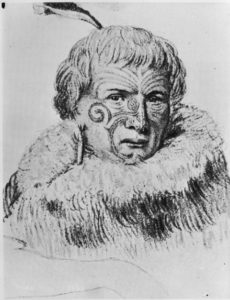1843: The Wairau Affray
June 17, 2020
By AHNZ
 Today in New Zealand history, 17 June, 1843, Wairau: An Affray followed by a Massacre.
Today in New Zealand history, 17 June, 1843, Wairau: An Affray followed by a Massacre.
Who owned the Wairau Plains? New Zealand Company were sure it was theirs, and its Cook Straight Settlers were busy trying to establish themselves in Nelson and Wellington. After all, they’d purchased the place more than once and this included their holding of the Blenkinsop Indenture. Their Wairau surveys had been going on all year, and all year they were shadowed and harassed by Te Rauparaha’s Ngai Toa.
 By June the survey was nearly completed when Chiefs Rauparaha and Te Rangihaeata arrived in their schooner (they’re a very wealthy tribe) with 2 dozen armed warriors. Every surveyor was rounded up by the Maoris and escorted to the coast. Their equipment was destroyed but the surveyors were not harmed and none of their personal property taken; They walked back to Nelson. Te Rauparaha had said he would (re)sell the land but only for “a very big cask of gold.” The chief had made a clever and calculated move and awaited the response of his opponent in this game of chess.
By June the survey was nearly completed when Chiefs Rauparaha and Te Rangihaeata arrived in their schooner (they’re a very wealthy tribe) with 2 dozen armed warriors. Every surveyor was rounded up by the Maoris and escorted to the coast. Their equipment was destroyed but the surveyors were not harmed and none of their personal property taken; They walked back to Nelson. Te Rauparaha had said he would (re)sell the land but only for “a very big cask of gold.” The chief had made a clever and calculated move and awaited the response of his opponent in this game of chess.
The Shortland Government, in the form of Land Commissioner William Spain, despite having established a hegemony over both parties in 1840, was as slow and useless at dispute resolution as its modern contemporary.
The Wairau Massacre
Cool Captain Arther Wakefield and fiery Magistrate Thompson were the law. They set out to apprehend the offending party and bring them to justice. Their judicial role was complicated by the fact that they were also members of the party injured by the Maori occupiers.
However, the Ngati Toa warriors had no inclination to wear Thompson’s handcuffs and have this matter settled back in a Nelson court. The two task forces faced off over either side of the Tuamarina Stream until the Colonials resolved to cross and make their arrest, led by Captain Wakefield calling “Englishmen forward.” The Maoris showed they weren’t bluffing, they were ready to fight, and soon overpowered Wakefield’s people. Someone, nobody knows who, fired a shot that ignited a short battle. The Colonial’s assault kept breaking, they were no soldiers and were soon outmatched.
Captain Wakefield, Thompson, a dozen survivors surrendered but they were not spared. In cold blood, after discussion and contemplation, the Maoris tomahawked their captives to death.
One offered rationale is that one of Te Rangihaeta’s auxiliary wives, O-Rongo, had died during the battle and that this had greatly aggrieved the chief. For this, vengeance had to be extracted. However, there are some other possibilities which you can read about in a future post on AHNZ.
“Ironside buried the dead with the chiefs’ permission, though Te Rangihaeta advised him to “leave them to the wild pigs”. The bodies were mutilated; Wakefield was found with his skull split by one blow, insulted in death by the laying of his pistol across his throat and the placing of a piece of damper bread under his sacred head.”- NZH
This move played, Ngai Toa and all Te Rauparaha’s Cloudy Bay Maori retreated back to the stronghold of the Kapiti Coast to await the retaliatory move from the Colonials.
The Empire Strikes Back?
 So who got the Wairau? To the fury of the Cook Straight Settlers, the new Governor Fitzroy makes nice with the Ngati Toa who had withdrawn- anticipating a walloping.
So who got the Wairau? To the fury of the Cook Straight Settlers, the new Governor Fitzroy makes nice with the Ngati Toa who had withdrawn- anticipating a walloping.
Instead, they are given the initiative and use it to sell the Wairau again.
Later, Ngai Tahu say it’s theirs, are also believed. Another opportunity for another Property Conveyancing opportunity for the Government! So the Wairau was sold once again and for a higher price than ever…(that’s another story.)
 Te Rauparaha was a big winner from his acts at Wairau and it would be left for a future Governor to tame him: George Grey.
Te Rauparaha was a big winner from his acts at Wairau and it would be left for a future Governor to tame him: George Grey.
The Cook Straight Settlers were already distrustful of The State up in Auckland that kept trying to ruin them and feed off them at the same time. The Wairau Affray and its handling could have led to a New Zealand Revolution, a South South Island independence. Indeed, they were politically organised as New Munster at this time.
What happened instead is that, eventually, the people of New Munster who hated the Hobson, Shortland, and Fitzroy Gangs so much took over The State themselves and became the Government until well into the C20th. Of course they became just as bad; Worse.
—
Image ref. Wairau memorial (1869) at Tuamarina cemetery; AHNZ coloured; Archives NZ; Flickr
Image ref. Te Rauparaha; Alexander Turnbull Library
Ref. NZH/New Zealand’s Heritage (1971)
2 thoughts on "1843: The Wairau Affray"
Leave a Reply
 Like Comment Share
Like Comment Share






The Stirring times of Te Rauparaha by WTL Travers has info on the Wairau.
Thanks. Does it say anything about the Wairau purchase and re-purchase? I’m interested in that angle.